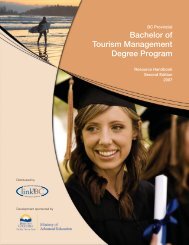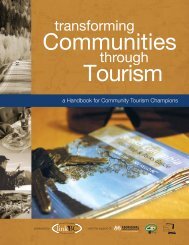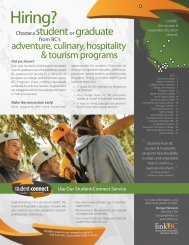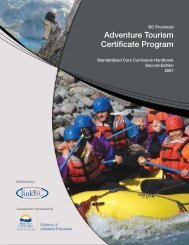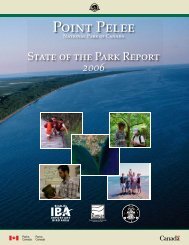Cultural Heritage Tourism Handbook - LinkBC
Cultural Heritage Tourism Handbook - LinkBC
Cultural Heritage Tourism Handbook - LinkBC
- No tags were found...
You also want an ePaper? Increase the reach of your titles
YUMPU automatically turns print PDFs into web optimized ePapers that Google loves.
3. <strong>Cultural</strong>/<strong>Heritage</strong> <strong>Tourism</strong> Visitors: Who Are They?This chapter will help you identify who the “cultural/heritage tourist” is, and ways your destinationcan capitalize on the wide interests of this growing group.3.1 Canadian Boomers Hit 65Baby boomers are the wealthiest and largest generation in Canadianhistory. They represent a tourism boom of sorts: as many becomeempty-nesters and move into retirement, their travel-related expenditureincreases for a window of a decade, more or less. However,after this ten-year period, with declining income and health, theirwindow for travel and leisure pursuits starts to narrow.Boomers are avid cultural consumers. They are the primary participantsin events including: tall ship festivals, heritage steam engineevents, culinary and wine festivals, veterans’ events, arts and craftsfairs, classic car shows and rallies, fine woodworking shows, and ahost of specialized hobby events that bring millions of dollars intoCanadian communities each year.A closer examination indicates this group is also involved in a widerange of volunteer activities in their communities, many in heritageand cultural institutions such as local museums and heritage properties.They enroll in clubs, associations, and take continuing educationcourses – and frequently become a formidable force in local politics.In this way, the interests and activities of this demographic areblurred between “visitors” and “residents”.Economic activity inevitably follows tourism demand. As interestin cultural experiences grows, new hotels, restaurants, specialevents, and specialized services become established. Tourists notonly visit and make purchases, but become permanent or—lessdesirably—part-time residents of the region. This process is calledamenity migration—people moving to a community because it isa great place to live.3.2 Culture as a Travel MotivatorThe <strong>Tourism</strong> Activities and Motivations Studies (TAMS), conductedby the Canadian <strong>Tourism</strong> Commission and its provincial/territorialpartners, reveal trends in the composition of the market, and in thepreferences of consumers. These trends directly support the argumentfor more and better cultural/heritage tourism development.TAMS conducted with Canadian 20 and US 21 markets found that, afterthe predictably popular shopping and dining (also arguably formsof cultural activity), cultural/heritage activities have the highestparticipation rates of all tourism activities for visitors from bothcountries. ‘Visiting heritage sites and museums’ consistently emergeas activities in which most participate. For Canadians, city strolling,visiting museums, and visiting heritage sites were the most popularactivities. Americans also like those activities, but put visiting casinosand amusement parks at the top of their list.“Within the leisure market segmentof the global travel industry, culture isarguably the single largest motivatorof international travel. Europe, whosetourism product is built primarily onculture, is the most visited continent.France, a nation that epitomizesculture, is the most visited country.”– Steven Thorne, <strong>Cultural</strong> <strong>Tourism</strong> SpecialistObservers ranging from the previously-quoted specialist Thorne tothe FPT team sponsoring this volume have noted Canada has not,traditionally, placed a great deal of emphasis on culture and heritagein its marketing. Our image-making has until quite recently beenfocused almost exclusively on our glorious natural and outdoorsettings we offer visitors. However, work by the Canadian <strong>Tourism</strong>How important are each of the followingconditions when choosing a destination foran overnight pleasure trip?Commission and provincial-territorial tourism agencies has revealedthat once core questions (of safety, security, comfort and affordability)have been addressed, visitors make decisions on where to travelbased on the availability of ‘lots to see and do,’ as this table 22 illustrates:HighlyImportantSomewhatImportantOf NoImportance% based on total number of Canadian travellers = 20.9 million.No health concerns at the destination 50% 38% 8%Feeling safe at the destination 66% 28% 4%Being familiar with the culture and language of the destination 14% 56% 27%Being at a place that is very different, culturally, than yours 9% 47% 40%Having friends or relatives living there 11% 27% 59%Low-cost package deals available for the destination 23% 50% 23%Destination is disabled-person friendly 6% 15% 73%Lots of things for children to see/do 17% 22% 56%Lots of things for adults to see/do 38% 51% 7%Information about the destination available on the internet 25% 43% 27%Great shopping opportunities 12% 41% 43%Availability of luxury accommodation 7% 26% 55%Availability of mid-range accommodation 29% 50% 13%Availability of budget accommodation 22% 44% 23%Availability of camping 13% 24% 51%Convenient access by car 43% 41% 11%Direct access by air 29% 42% 22%Convenient access by train/bus 13% 37% 39%Not stated 1 %1617



